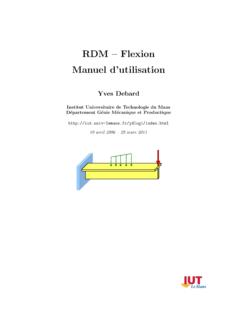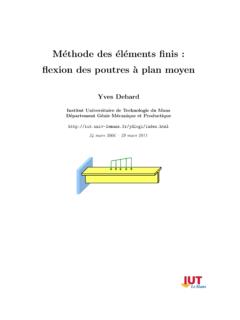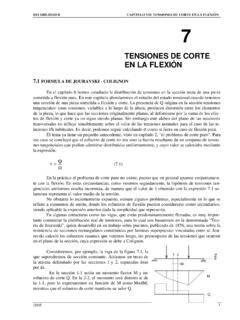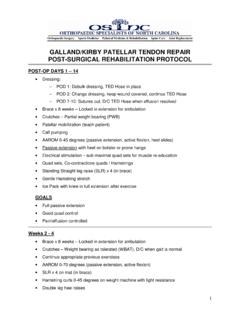Transcription of FLEXION / EXTENSION SIDEBENDING ROTATION
1 Cervical Spine Stretches Purpose: Stretching exercises help to restore joint range of motion by lengthening shortened muscles and connective tissue, which helps to reduce pain and tightness. Instructions: 1. Perform highlighted stretches initially 1-2 x/day, or _____ 2. Hold each stretch 30-60 seconds if tolerated for lengthening of muscles; repeat 2-3x/each or _____ 3. Stretch to your pain-free end point, then breathe deeply through your belly and relax as you exhale. This will encourage maximal range in that stretch. 4. It is best to stretch with a warmed-up body, about the temperature that causes a light sweat. 5. For pain reduction, it is best to stretch tight muscles at night just before going to bed.
2 6. If it is not T STRETCH IT! When tight muscles are no longer tight, you may decrease frequency to 2-3 times per week. 7. Maintain good, upright posture with all stretches and avoid shrugging your shoulders! ROTATION Turn to look over your right shoulder; hold, then switch sides. Add gentle hand pressure at the chin as tolerated for more stretch. SIDEBENDING Bend your ear toward your right shoulder while looking straight ahead; hold, then alternate. FLEXION / EXTENSION Bring your chin toward your chest; hold. Return to upright, then bring your head back; hold. Hold the back of your neck with your hands if you need more support. SCALENE Sit with your right hand holding edge of chair.
3 Place your left hand over your right collarbone to stabilize. Pull chin back, tip ear toward left shoulder, turn to look over left shoulder and hold. Repeat on right side. MODIFICATION: Begin in the same position, but now tip left ear to left shoulder, and tip head back as if drinking out of a cup. UPPER TRAPEZIUS Sit with right hand holding edge of chair. Move chin towards chest, tilt your left ear toward your left shoulder turn right to look up toward the ceiling. Left hand can be used for overpressure-DON T PULL. Repeat to right side. LEVATOR SCAPULAE Sit with right hand holding edge of chair. Tip chin towards chest, tip ear toward your left shoulder and nose toward your left armpit.
4 Left hand can be used for gentle overpressure-DON T PULL. Alternate. For a deeper stretch: Lift right arm up and place hand behind neck. Avoid shrugging. Tilt left ear toward left shoulder, turn head to left, and bend chin down. Alternate. Thoracic Spine & Postural Stretches PECTORALS Stand either in a doorway or facing a corner. Place your palms/forearms on each side of the corner or doorframe. Place one foot in front of the other and lean your chest forward and hold. Support your body with your legs, not with your arms. Keep your head and chest up in a good posture. Step 1: Sit, stand or lie on your back Place your elbows, forearms and palms together in front of your chest.
5 Step 2: Keep your elbows as close together as possible while you raise your elbows over head. Step 3: Turn your palms up then out. If lying, try to lower your arms to the floor. Step 4: Lower your elbows down the sides of your body. If lying, continue to keep your elbows in contact with the floor. Keep palms turned out as if you re opening curtains. THORACIC TOWEL ROLL STRETCH Lie on your back with knees bent, and place a towel roll across shoulder blades. Relax for as long as tolerated up to 5 minutes, 1-3 times per day. As this becomes more tolerable, raise arms above head and tuck chin for a better stretch. To stretch chest muscles, tuck chin and place arms at sides, elbows bent and positioned at 90 degrees.
6 ALTERNATE: Place towel vertically. TRIGGER POINT RELEASE Using a Theracane, tennis ball, or trigger ball, give gentle direct pressure to tight muscles and knots. Hold or gently massage areas 60-90 seconds each, once daily. Tip: Placing two tennis balls in a sock works well to release the suboccipitals and improve headaches; use the tennis ball against the wall for knots along shoulder blades. LOWER TRAPEZIUS MOBILIZATION Step 5: Straighten your elbows and pull your hands down along you sides. Pause and relax while breathing slowly. Repeat the stretch 2-3 times. HEAD AND SCAPULAR RETRACTION Pull chin straight back (without tucking it down). Squeeze shoulder blades down and together, then rotate palms outward and hold.
7 Daily Cervical Stabilization Exercises Purpose: The most common muscles to become weak for those with neck dysfunction are the cervical flexors. The deep neck flexors are significant contributors to the stability of the cervical spine. These exercises will strengthen the deep flexors to improve posture and decrease strain on the spine, which can decrease neck pain and headaches. Instructions: 1. Hold 10 seconds & Repeat 10 times. 2. Maintain DLC. 3.
8 Complete 1-2 times per day. 4. This should be pain-free. Drop back at least one level and consult your therapist if this causes pain. 5. Progress to the next exercise when you can complete a 10 second hold for 10 repetitions without fatigue. 6. Once able to perform level 3 easily, decrease frequency to 1x/week to maintain strength. 7. If participating in circuit program, you may discontinue this exercise. LEVEL 1: SEATED HEAD NOD Sit upright with good posture. Hold your neck with your hands or sit or stand against a wall with the back of your head against the wall for some support. Gently nod head by bringing your chin toward your Adam s apple.
9 You should feel the back of your neck stretch and the front of your neck tighten. DO NOT ALLOW THE LARGE MUSCLES IN THE FRONT OF YOUR NECK TO TIGHTEN (you can place your fingers on the front of your neck to make sure.) Focus on the small muscles around your throat. Hold 10 seconds, repeat 10 times. ALTERNATE: Complete while sitting in your car with your head against the head rest. LEVEL 2: SUPINE HEAD NOD Lie on your back with your head on a firm surface and a towel roll under your neck. Gently nod your head by bringing your chin towards your Adam s apple. Do not lift your head off of the table, and maintain contact with the towel roll. Feel the back of your neck lengthen and the front of your neck tighten.
10 LEVEL 3: SUPINE HEAD LIFT Lie on your back with your head on a firm surface and a towel roll supporting your neck. Gently nod your chin toward your Adam s apple and lift your head up slightly. Do not lose contact with the towel roll. Feel the back of your neck lengthen and the front of your neck tighten. Cervical Isometric Exercises Purpose: To strengthen muscles in the neck and/or maintain strength gained in the MedX machines. Instructions: 1. Do only the exercises instructed by your therapists. 2. Remember to hold the DLC, then begin the exercises. 3. Hold each exercise for a total of 10 seconds. Ramp up the pressure into your hands (or ball) for 2 seconds, push at maximum pressure for 6 seconds, then slowly release the pressure for the final 2 seconds.






